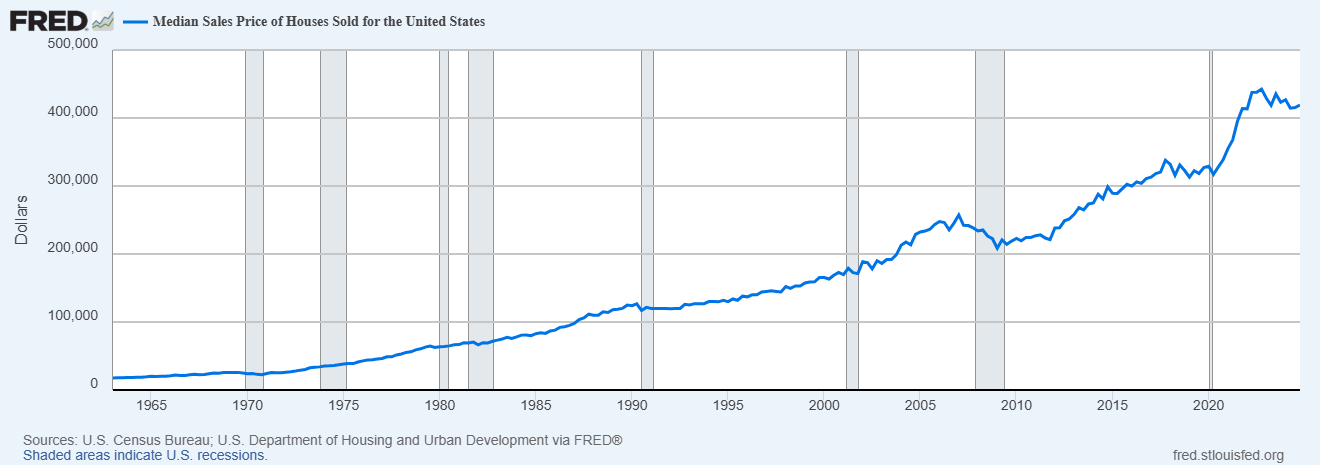From housing to groceries, American households are struggling under rising costs. But who's really to blame for this broken system? Let's take a closer look.
We've all heard it: Get a good job, save diligently, and you'll afford a home someday. But more and more people in the U.S. are realising that this advice doesn't hold up anymore. Millennials and Gen Z workers, despite earning decent wages in many cases, find themselves locked out of homeownership.
The truth is: if you can't afford a home in the U.S. today, it's not because you're failing—it's because the system isn't designed to work for you.
The Housing Crisis in Numbers
The U.S. housing market is painfully unaffordable for most people, and the numbers back this up:
- Median Home Prices: As of February 2025, the median existing-home price for all housing types was $398,400, a 3.8% increase from the previous year.
- Rents Skyrocket: The average rent in the U.S. reached $1,980 in February 2025, reflecting a 3.5% year-over-year increase.
- Demand vs. Supply: The U.S. faces a housing shortage of approximately 3.7 million units, with supply continually falling short of demand.

With these staggering statistics, one thing is clear: the dream of homeownership has been turned into a nightmare—one engineered by economic and political systems stacked in favour of a wealthy elite.
Why Homes Are Unaffordable
At the heart of the U.S. housing crisis lies wealthy investors, speculative markets, and decades of inadequate policy. The recipe for unaffordable housing includes the following ingredients:
1. Landlords and Institutional Investors Dominate the Market
In the U.S., homes are increasingly treated as money-making investments rather than a basic human need. Institutional investors dominate the market, buying large chunks of housing stock to turn a profit through rent and rising property values. These corporate landlords drive up prices and leave aspiring buyers unable to compete.

2. Wealth and Speculation Fuel Soaring Prices
Wealth inequality amplifies the demand for assets like real estate, pricing everyday people out. Housing becomes not a place to live but a financial asset for the wealthy to grow their portfolios. As speculation takes over, housing prices spiral far beyond average income levels.
3. Stagnant Wages Compound the Problem
Even as house prices climb year after year, wage growth has failed to keep up. For younger people, saving for a deposit while also paying steep rent is next to impossible. Housing costs now consume a much larger share of income than they did for previous generations, leaving thousands trapped in a cycle of renting with no viable path to ownership.
4. Limited Government Action
Despite the glaring issues, policies in the U.S. have fallen short of fixing the crisis. Public housing projects are underfunded, and regulations to limit investor control or stabilise rent hikes have been insufficient. Without stronger intervention, the situation continues to worsen.
What This Means for Families in the U.S.
The effects of unaffordable housing ripple far beyond homeownership. Here's what happens when a basic necessity is too expensive for most:
- Financial Insecurity: Families unable to own homes struggle to save and plan for the future.
- Generational Inequality: Young American workers are at risk of never building the wealth older generations took for granted.
- Broken Communities: Expensive housing erodes communities as workers are forced to migrate further from cities or move abroad entirely.
This isn't just a personal issue. It's a systemic failure that leaves everyday people paying the price of policies and markets geared toward profit over people.
What Can Be Done?
The U.S. doesn't have to remain trapped in this cycle of unaffordable housing. Real change starts with addressing the root problem: economic inequality. Here are some solutions to rebalance the scales:
1. Tax the Wealthy
Implement progressive property taxes targeting large portfolios owned by institutional investors. This would discourage speculative buying and generate revenue to build affordable housing.
2. Massively Expand Public Housing
The government must invest substantially in affordable social housing projects. This would remove dependency on profit-driven private developers, ensuring supply grows in line with public needs.
3. Close Investor Loopholes
Introduce stronger restrictions on corporate landlords and limit large-scale purchases by institutional investors. This would stop wealthy groups from dominating the housing market.
4. Rent Control and Tenant Protections
Rent caps and stronger tenant rights laws would ensure families aren't displaced by arbitrary rent hikes, creating more balanced housing stability.
It's Not Our Fault
If you're struggling to buy a home in the U.S., let this be clear: it is not our fault. The housing market has been hijacked by investment interests and a system designed to enrich the wealthy at the expense of everyone else.
But things can change. By pushing for bold policies, supporting progressive housing reforms, and demanding fairness in the market, ordinary people can reclaim access to affordable homes.
Housing is not—and should never be—a luxury.
It's time the U.S. made it a right for all.
Let's work together to build a fair housing system, so everyone can call the U.S. home.
